Application of Sentinel-2 Multispectral Data for Habitat Mapping of Pacific Islands: Palau Republic (Micronesia, Pacific Ocean)
Abstract
:1. Introduction
2. Materials and Methods
2.1. Study Area
2.2. Image Processing and Shallow-Water Benthic Classification
2.3. Validation of Image Interpretation
3. Results
4. Discussion
4.1. Shoreline, Mangroves, Coral Reefs, and Seagrasses
4.2. Limits and Challenges of the Present Approach vs. Similar Studies
5. Conclusions
Supplementary Materials
Author Contributions
Funding
Acknowledgments
Conflicts of Interest
References
- Hoegh-Guldberg, O.; Mumby, P.J.; Hooten, A.J.; Steneck, R.S.; Greenfield, P.; Gomez, E.; Harvell, C.D.; Sale, P.F.; Edwards, A.J.; Caldeira, K.; et al. Coral Reefs Under Rapid Climate Change and Ocean Acidification. Science 2007, 318, 1737–1742. [Google Scholar] [CrossRef] [Green Version]
- Waycott, M.; McKenzie, L.M.; Mellors, J.E.; Ellison, J.C.; Sheaves, M.T.; Collier, C.; Schwarz, A.; Webb, A.; Johnson, J.E.; Payri, C.E. Vulnerability of mangroves, seagrasses and intertidal flats in the tropical Pacific to climate change. In Vulnerability of Tropical Pacific Fisheries and Aquaculture to Climate Change; Bell, J.D., Johnson, J.E., Hobday, A.J., Eds.; Secretariat of the Pacific Community: Noumea, New Caledonia, 2011. [Google Scholar]
- Hoegh-Guldberg, O.; Poloczanska, E.S.; Skirving, W.; Dove, S. Coral Reef Ecosystems under Climate Change and Ocean Acidification. Front. Mar. Sci. 2017, 4, 00158. [Google Scholar] [CrossRef]
- Smale, D.A.; Wernberg, T.; Oliver, E.C.J.; Thomsen, M.; Harvey, B.P.; Straub, S.C.; Burrows, M.T.; Alexander, L.V.; Benthuysen., J.A.; Donat, M.C.; et al. Marine heatwaves threaten global biodiversity and the provision of ecosystem services. Nat. Clim. Chang. 2019, 306, 306–312. [Google Scholar] [CrossRef]
- Hughes, T.P.; Baird, A.H.; Bellwood, D.R.; Card, M.; Connolly, S.R.; Folke, C.; Grosberg, R.; Hoegh-Guldberg, O.; Jackson, J.B.; Kleypas, J. Climate Change, Human Impacts, and the Resilience of Coral Reefs. Science 2003, 301, 929–933. [Google Scholar] [CrossRef] [Green Version]
- Grottoli, A.G.; Rodrigues, L.J.; Palardy, J.E. Heterotrophic plasticity and resilience in bleached corals. Nature 2006, 440, 1186–1189. [Google Scholar] [CrossRef]
- Wilkinson, C.R.; Buddemeier, R.W. Global Climate Change and Coral Reefs: Implications for People and Reefs; Technical Report for the UNEP-IOC-ASPEI-IUCN Global Task Team on the Implications of Climate Change on Coral Reefs; IUCN: Gland, Switzerland, 1994. [Google Scholar]
- Mumby, P.J.; Harborne, A.R. Development of a systematic classification scheme of marine habitats to facilitate regional management and mapping of Caribbean coral reefs. Biol. Conserv. 1999, 88, 155–163. [Google Scholar] [CrossRef]
- Jupiter, S.; Roelfsema, C.M.; Phinn, S.R. Science and management. In Coral Reef Remote Sensing; Goodman, J.A., Phinn, S.R., Purkis, S., Eds.; Springer: Berlin, Germany, 2013; pp. 403–427. [Google Scholar]
- Hedley, J.D.; Roelfsema, C.M.; Chollett, I.; Harborne, A.R.; Heron, S.F.; Weeks, S.; Skirving, W.J.; Strong, A.E.; Eakin, C.M.; Christensen, T.R.L.; et al. Remote Sensing of Coral Reefs for Monitoring and Management: A Review. Remote Sens. 2016, 8, 118. [Google Scholar] [CrossRef]
- Green, E.P.; Mumby, P.J.; Edwards, A.J.; Clark, C.D. A review of remote sensing for the assessment and management of tropical coastal resources. Coast. Manag. 1996, 24, 1–40. [Google Scholar] [CrossRef]
- Phinn, S.R.; Roelfsema, C.M.; Stumpf, R. Remote sensing: Discerning the promise from the reality. In Integrating and Applying Science: A Handbook for Effective Coastal Ecosystem Assessment; Longstaff, B.J., Carruthers, T.J.B., Dennison, W.C., Lookingbill, T.R., Hawkey, J.M., Thomas, J.E., Wicks, E.C., Woerner, J., Eds.; IAN Press: Cambridge, MD, USA, 2010. [Google Scholar]
- Phinn, S.R.; Hochberg, E.; Roelfsema, C.M. Airborne photography, multispectral and hyperspectral remote sensing on coral reefs. In Coral Reef Remote Sensing; Goodman, J.A., Phinn, S.R., Purkis, S., Eds.; Springer: Berlin, Germany, 2013; pp. 3–25. [Google Scholar]
- Andréfouët, S.; Claereboudt, M.; Matsakis, P.; Pagès, J.; Dufour, P. Typology of atoll rims in Tuamotu Archipelago (French Polynesia) at landscape scale using SPOT HRV images. Int. J. Remote Sens. 2001, 22, 987–1004. [Google Scholar] [CrossRef]
- Andréfouët, S.; Kramer, P.; Torres-Pulliza, D.; Joyce, K.E.; Hochberg, E.J.; Garza-Pérez, R.; Mumby, P.J.; Riegl, B.; Yamano, Y.; White, W.H.; et al. Multi-site evaluation of IKONOS data for classification of tropical coral reef environments. Remote Sens. Environ. 2003, 88, 128–143. [Google Scholar]
- Naseer, A.; Hatcher, B.G. Inventory of the Maldives coral reefs using morphometrics generated from LANDSAT ETM+ imagery. Coral Reefs 2004, 23, 161–168. [Google Scholar] [CrossRef]
- Yamano, H.; Shimazaki, H.; Matsunaga, T.; Ishoda, A.; McClennen, C.; Yokoki, H.; Fujita, K.; Osawa, Y.; Kayanne, H. Evaluation of various satellite sensors for waterline extraction in a coral reef environment: Majuro Atoll, Marshall Islands. Geomorphology 2006, 82, 398–411. [Google Scholar] [CrossRef]
- Naseer, A.; Hatcher, B.G. Assessing the integrated growth response of coral reefs to monsoon forcing using morphometric analysis of reefs in Maldives. In Proceedings of the 9th International Coral Reef Symposium, Bali, Indonesia, 23–27 October 2000; Volume 1, pp. 75–80. [Google Scholar]
- Storlazzi, C.D.; Logan, J.B.; Field, M.E. Quantitative morphology of a fringing reef tract from high resolution laser bathymetry: Southern Molokai, Hawaii. Geol. Soc. Am.Bull. 2003, 115, 1344–1355. [Google Scholar] [CrossRef]
- Giardino, C.; Bresciani, M.; Fava, F.; Matta, E.; Brando, V.E.; Colombo, R. Mapping Submerged Habitats and Mangroves of Lampi Island Marine National Park (Myanmar) from in Situ and Satellite Observations. Remote Sens. 2016, 8, 2. [Google Scholar] [CrossRef]
- Andréfouët, S.; Muller-Karger, F.E.; Robinson, J.A.; Kranenburg, C.J.; Torres-Pulliza, D.; Spraggins, S.A.; Murch, B. Global assessment of modern coral reef extent and diversity for regional science and management applications: A view from space. In Proceedings of the 10th International Coral Reef Symposium, Okinawa, Japan, 28 June–2 July 2004; Volume 2, pp. 1732–1745. [Google Scholar]
- Hedley, J.D.; Roelfsema, C.M.; Phinn, S.R.; Mumby, P.J. Environmental and sensor limitations in optical remote sensing of coral reefs: Implications for monitoring and sensor design. Remote Sens. 2012, 4, 271–302. [Google Scholar] [CrossRef]
- Hedley, J.; Roelfsema, C.; Koetz, B.; Phinn, S. Capability of the SENTINEL-2 mission for tropical coral reef mapping and coral bleaching detection. Remote Sens. Environ. 2012, 120, 145–155. [Google Scholar] [CrossRef]
- Hedley, J.D.; Roelfsema, C.; Brando, V.; Giardino, C.; Kutser, T.; Phinn, S.; Mumby, P.J.; Barrilero, O.; Laporte, J.; Koetz, B. Coral reef applications of Sentinel-2: Coverage, characteristics, bathymetry and benthic mapping with comparison to Landsat 8. Remote Sens. Environ. 2018, 216, 598–614. [Google Scholar] [CrossRef]
- Golbuu, Y.; Bauman, A.J.; Kuartei, J.; Victor, S. The State of Coral Reef Ecosystems of Palau. In The State of Coral Reef Ecosystems of the United States and Pacific Freely Associated States; Waddell, J., Ed.; NOAA Technical Memorandum NOS NCCOS 11; NOAA/NCCOS Center for Coastal Monitoring and Assessment Biogeography Team: Silver Spring, MD, USA, 2005; pp. 488–507. [Google Scholar]
- Kerra, M.J.; Purkisb, S. An algorithm for optically-deriving water depth from multispectral imagery in coral reef landscapes in the absence of ground-truth data. Remote Sens. Environ. 2018, 210, 307–324. [Google Scholar] [CrossRef]
- Hedley, J.D.; Harborne, A.R.; Mumby, P.J. Technical note: Simple and robust removal of sun glint for mapping shallow-water benthos. Int. J. Remote Sens. 2005, 26, 2107–2112. [Google Scholar] [CrossRef]
- Richards, J.A. Remote Sensing Digital Image Analysis. An Introduction; Springer: Berlin, Germany, 2006; pp. 1–454. [Google Scholar]
- Mumby, P. Methodologies for Defining Habitats. In Tropical Coastal Management. Habitat Classification and Mapping; Edwards, A.J., Ed.; UNESCO: Paris, France, 2000; pp. 131–139. [Google Scholar]
- Foster, G.; Gleason, A.; Costa, B.; Battista, T.; Taylor, C. Acoustic application. In Coral Reef Remote Sensing, A Guide for Mapping, Monitoring and Management; Goodman, J.A., Purkis, S.J., Phinn, S.R., Eds.; Springer: New York, NY, USA, 2013; pp. 221–225. [Google Scholar]
- Bouvet, G.; Ferraris, J.; Andrefouet, S. Evaluation of large-scale unsupervised classification of New Caledonia reef ecosystem using Landsat ETM+ imagery. Oceanol. Acta 2003, 26, 281–290. [Google Scholar] [CrossRef]
- NOAA Biogeography Branch. Shallow-Water Benthic Habitats of American Samoa, Guam, and the Commonwealth of the Northern Mariana Islands: Manual; NOAA National Ocean Service, National Centers for Coastal Ocean Science: Silver Spring, MD, USA, 2005; p. 33. [Google Scholar]
- Analytical Laboratories of Hawaii. Mapping of Benthic Habitat of Palau; Technical Report for NOAA; NOAA: Silver Spring, MD, USA, 2007; pp. 1–37. [Google Scholar]
- Padma, S.; Sanjeevi, S. Jeffries Matusita based mixed-measure for improved spectral matching in hyperspectral image analysis. Int. J. Appl. Earth Obs. Geoinf. 2014, 32, 138–151. [Google Scholar] [CrossRef]
- Hochberg, E.J.; Atkinson, M.J.; Andrefouet, S. Spectral reflectance of coral reef bottom-types worldwide and implications for coral reef remote sensing. Remote Sens. Environ. 2003, 85, 159–173. [Google Scholar] [CrossRef]
- Weisstein, E.W. Coastline Paradox. From MathWorld-A Wolfram Web Resource. Available online: http://mathworld.wolfram.com/CoastlineParadox.html (accessed on 22 August 2019).
- Bhattarai, B.; Giri, C. Assessment of mangrove forests in the Pacific region using Landsat imagery. J. Appl. Remote Sens. 2011, 5, 1–11. [Google Scholar] [CrossRef]
- Barkley, H.C.; Cohen, A.L.; Mollica, N.R.; Brainard, R.E.; Rivera, H.E.; DeCarlo, T.M.; Lohmann, J.P.; Drenkard, E.J.; Alpert, A.E.; Young, C.W.; et al. Repeat bleaching of a central Pacific coral reef over the past six decades (1960–2016). Commun. Biol. 2018, 1, 1–10. [Google Scholar] [CrossRef]
- Colin, P.L. Ocean warming and the reefs of Palau. Oceanography 2018, 31, 126–135. [Google Scholar] [CrossRef]
- Collier, C.J.; Waycott, M. Temperature extremes reduce seagrass growth and induce mortality. Mar. Pollut. Bull. 2014, 83, 483–490. [Google Scholar] [CrossRef]
- Ellison, J.C. Possible impacts of predicted sea-level rise on South Pacific mangroves. In Sea-Level Changes and Their Effects; Noye, J., Grzechnik, M., Eds.; World Scientific: Singapore, 2001; pp. 49–72. [Google Scholar]
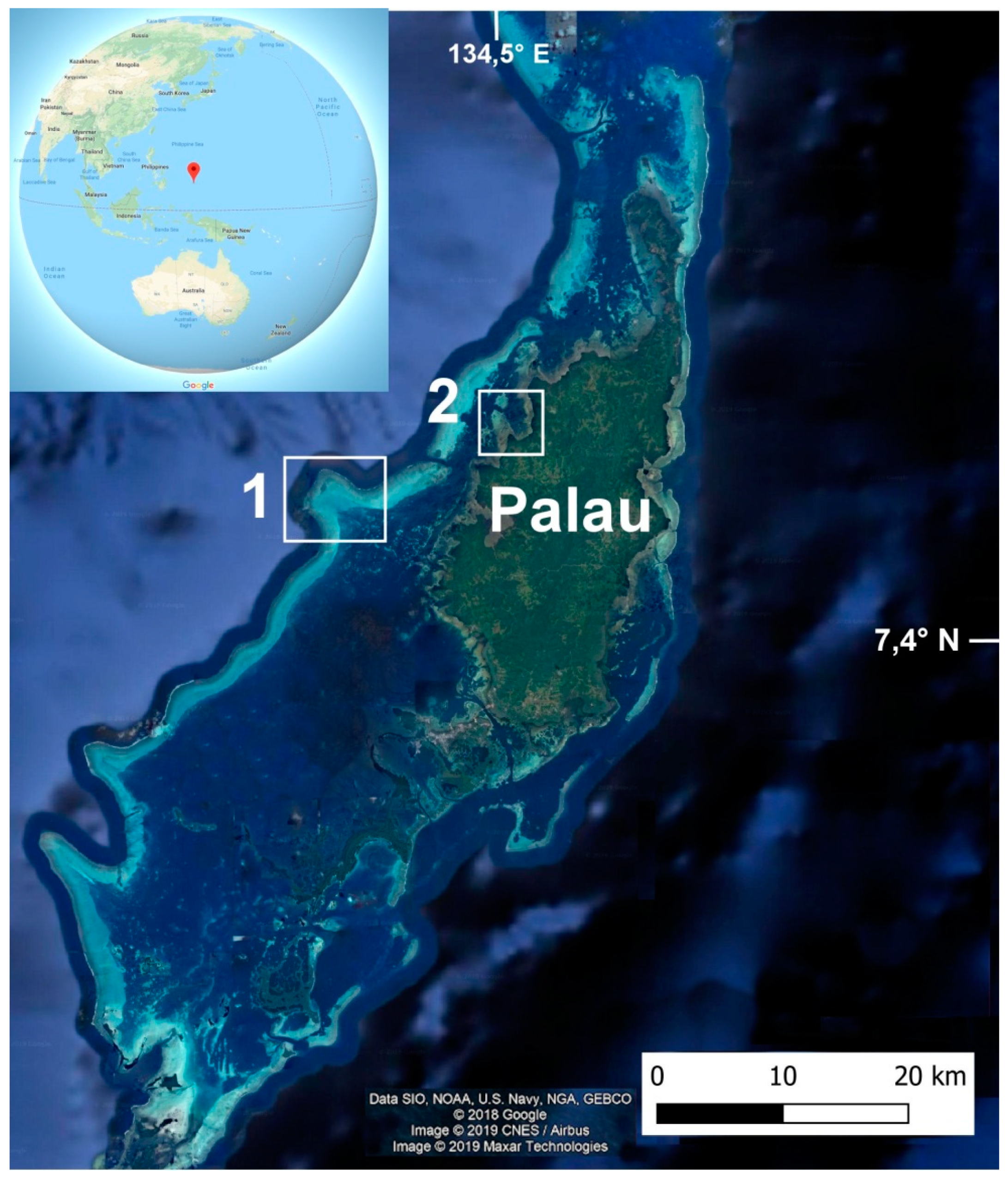

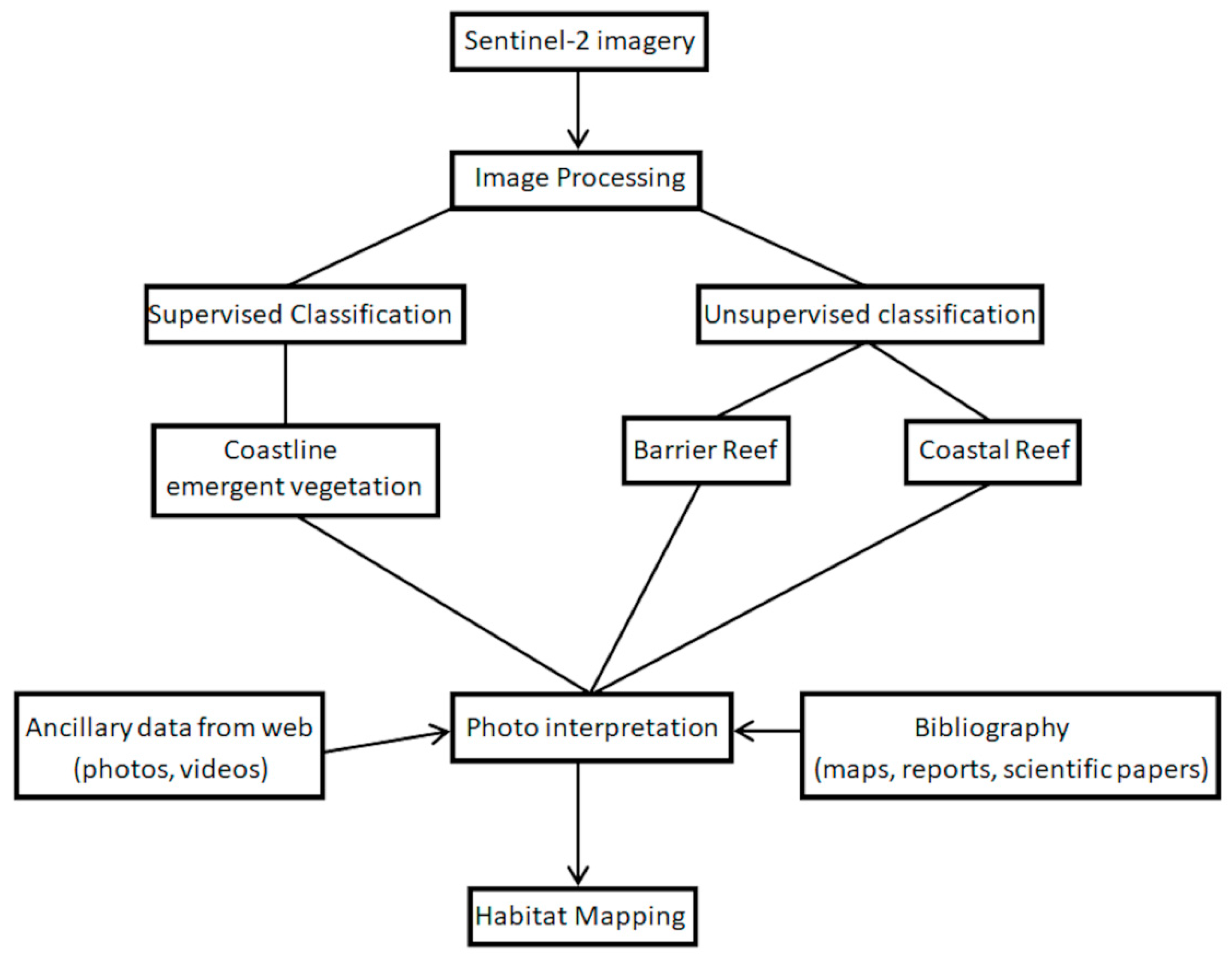
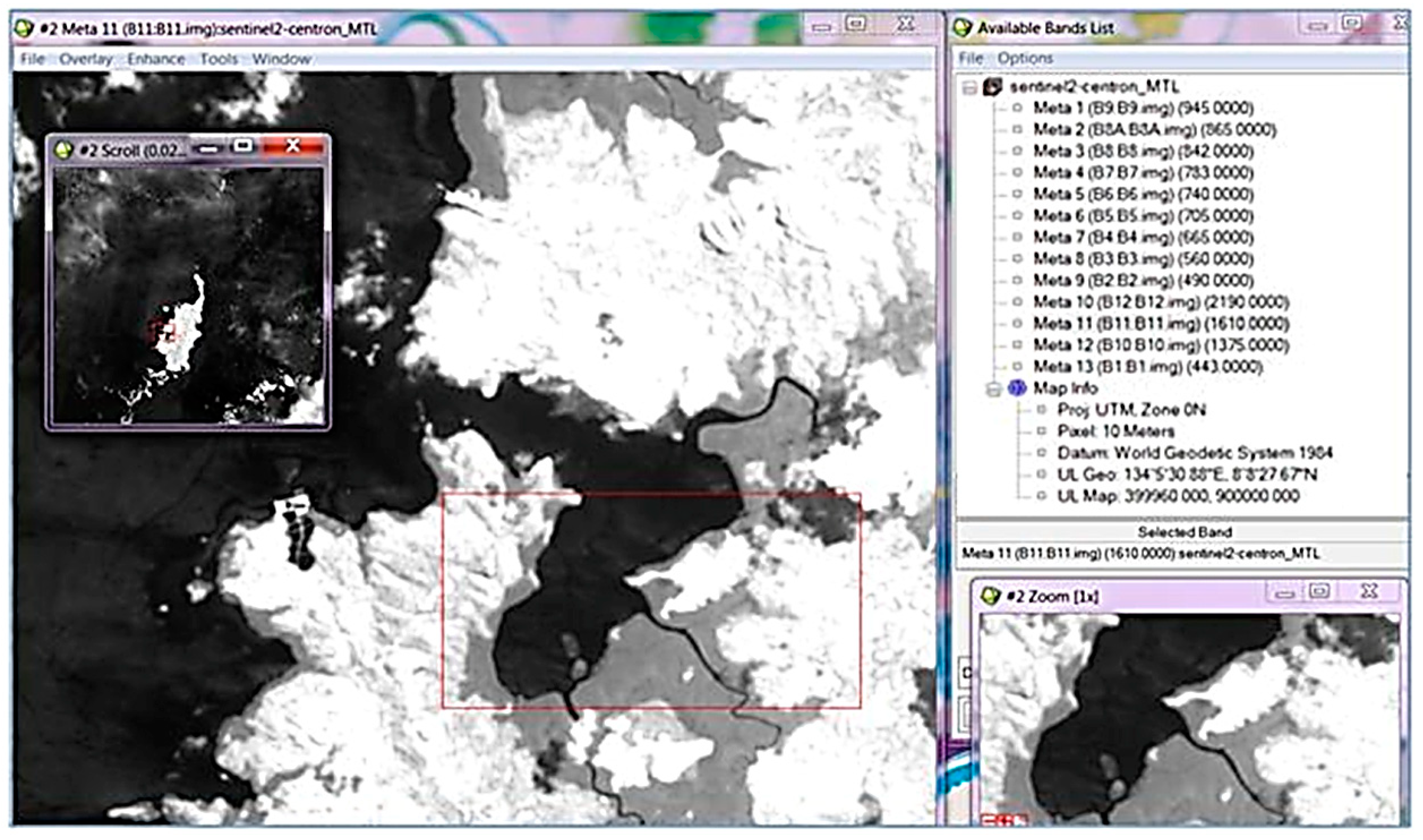
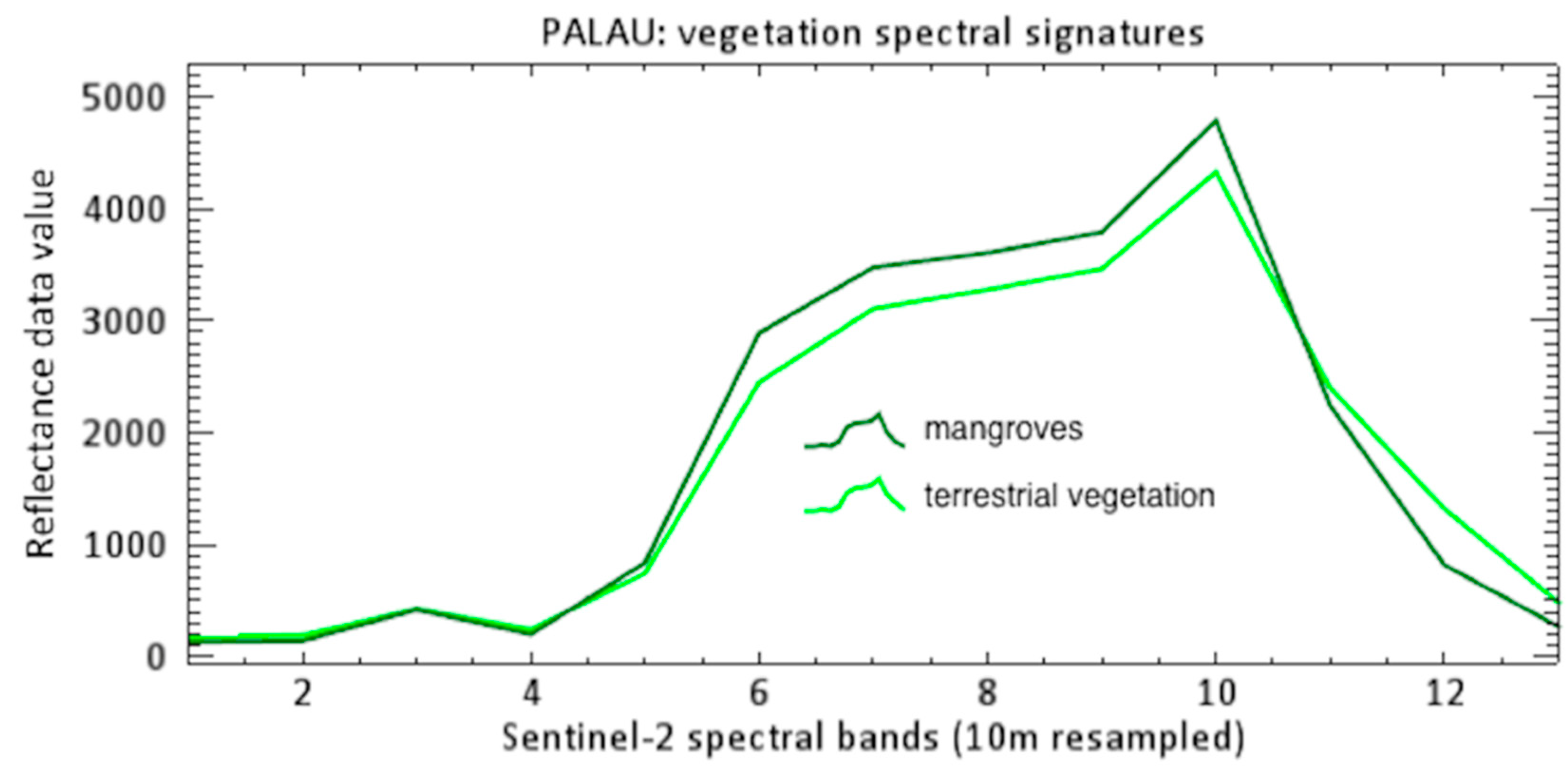
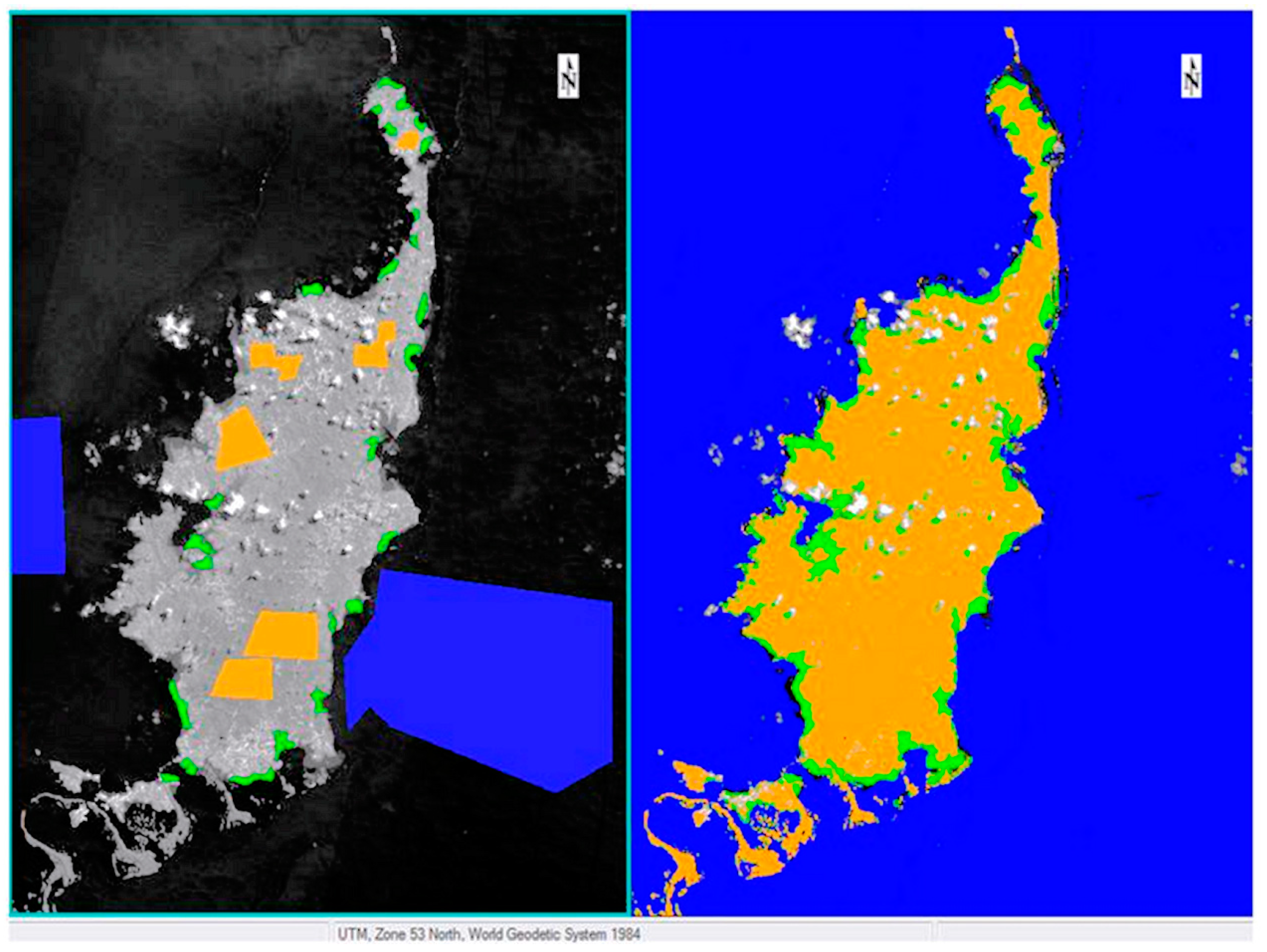



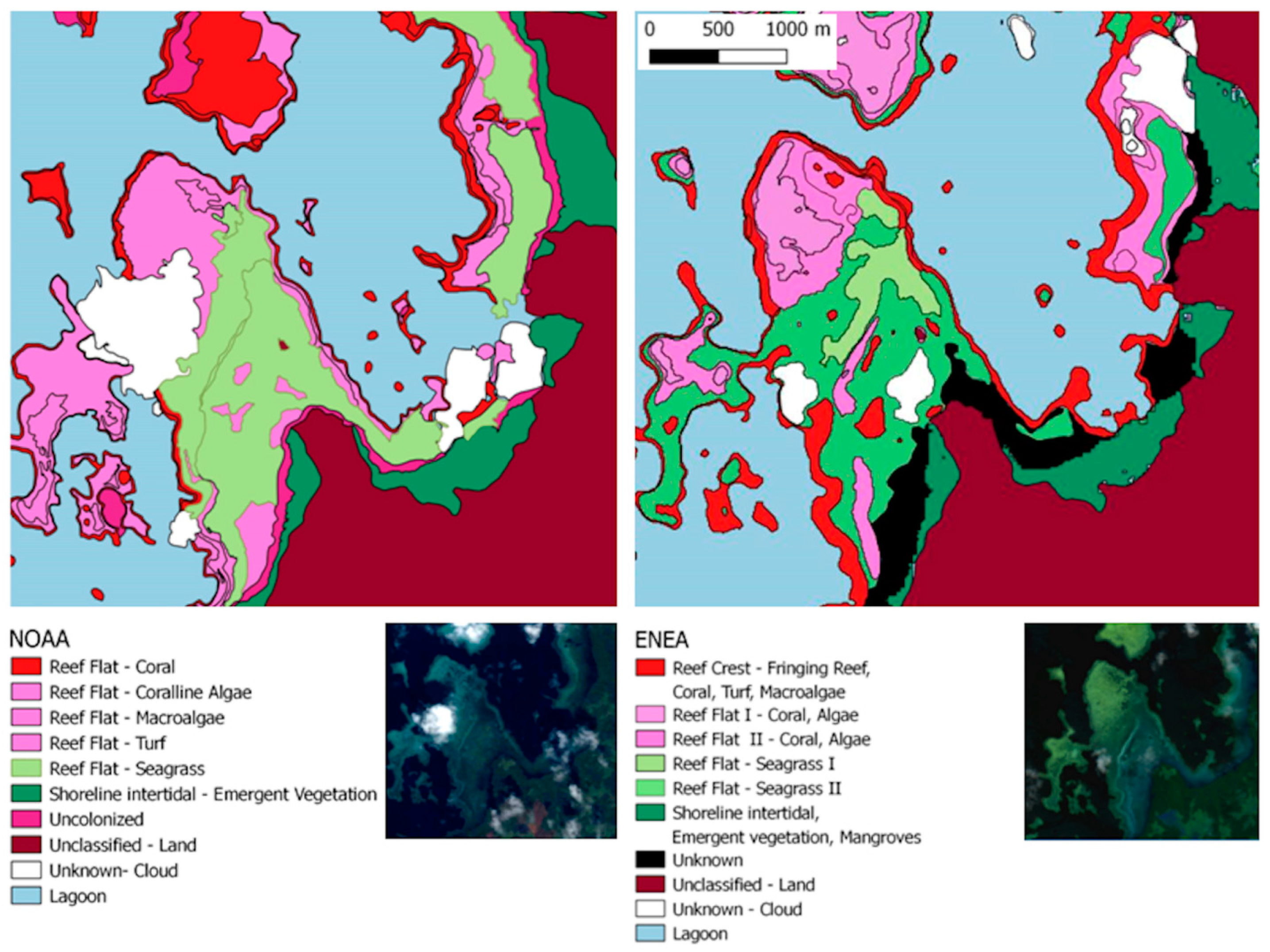
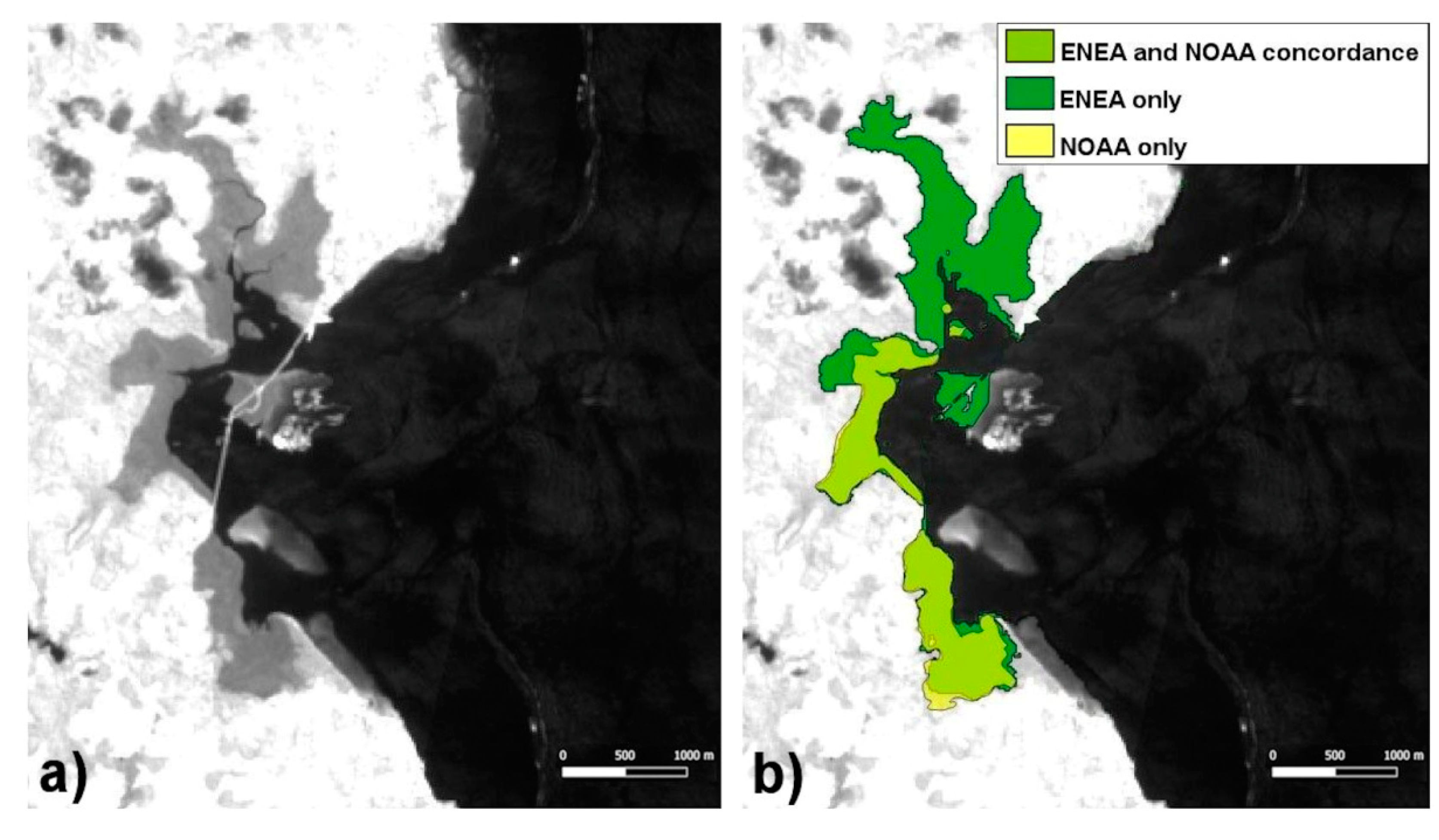
| Zone | Habitat Classes | Habitat Subclasses | Geomorphological Description | Biological Relevance |
|---|---|---|---|---|
| Barrier Reef | Bank/shelf and fore reef | coral, coralline algae | underwater coral cliff | dense coral, high biodiversity, coral reservoir |
| Reef crest | coral, coralline algae | windward coral platform shelf edge, algae ridge | dense coral, high biodiversity | |
| Back reef | scattered coral, flesh algae | coral platform, sand channels | medium to scarse coral density | |
| Patch reef | coral/coralline algae | coral knob, aggregate coral | medium coral density, coral reservoir | |
| Lagoon | sand coral knoll, massive coral | sand, rubbles, coral | medium to dense coral density, coral reservoir | |
| Coastal Reef | Reef crest | coral, coralline algae | seaward coastal coral platform, shelf edge | high coral density, high biodiversity, coral reservoir |
| Reef flat | coral, flesh algae, seagrasses | coral platform | high coral density, high biodiversity, coral reservoir | |
| Uncolonized | outward limit of mangrove area | sand/mud | nursery area for fish, shrimps, etc. | |
| Emergent vegetation | mangrove | intertidal/sand/mud | high primary productivity area |
| Zone | ENEA | NOAA | ENEA vs. NOAA |
|---|---|---|---|
| 2017 | (2003–2006) | (%) | |
| Shoreline (km) | 1213 | 1021 | +18.8 |
| Mangroves area (ha) | 5500 | 4400 | +25.0 |
| Zone | Jeffries-Matusita Coefficients |
|---|---|
| Land–Sea | 2.000–2.000 |
| Sea–Mangroves | 2.000–2.000 |
| Land–Mangroves | 1.999–1.999 |
| Zone | Habitat Classes | ENEA (ha) | NOAA (ha) | ENEA vs. NOAA Overall Accuracy (%) |
|---|---|---|---|---|
| Bank/shelf and fore reef | 12,003 | 10,688 | 52.9 | |
| Barrier reef | Reef crest and back reef | 40,568 | 33,794 | 54.6 |
| Lagoon | 9512 | 11,940 | 44.3 | |
| Coastal reef | Reef crest | 1555 | 2351 | 39.8 |
| Reef flat | 4231 | 3222 | 56.8 |
© 2019 by the authors. Licensee MDPI, Basel, Switzerland. This article is an open access article distributed under the terms and conditions of the Creative Commons Attribution (CC BY) license (http://creativecommons.org/licenses/by/4.0/).
Share and Cite
Immordino, F.; Barsanti, M.; Candigliota, E.; Cocito, S.; Delbono, I.; Peirano, A. Application of Sentinel-2 Multispectral Data for Habitat Mapping of Pacific Islands: Palau Republic (Micronesia, Pacific Ocean). J. Mar. Sci. Eng. 2019, 7, 316. https://doi.org/10.3390/jmse7090316
Immordino F, Barsanti M, Candigliota E, Cocito S, Delbono I, Peirano A. Application of Sentinel-2 Multispectral Data for Habitat Mapping of Pacific Islands: Palau Republic (Micronesia, Pacific Ocean). Journal of Marine Science and Engineering. 2019; 7(9):316. https://doi.org/10.3390/jmse7090316
Chicago/Turabian StyleImmordino, Francesco, Mattia Barsanti, Elena Candigliota, Silvia Cocito, Ivana Delbono, and Andrea Peirano. 2019. "Application of Sentinel-2 Multispectral Data for Habitat Mapping of Pacific Islands: Palau Republic (Micronesia, Pacific Ocean)" Journal of Marine Science and Engineering 7, no. 9: 316. https://doi.org/10.3390/jmse7090316
APA StyleImmordino, F., Barsanti, M., Candigliota, E., Cocito, S., Delbono, I., & Peirano, A. (2019). Application of Sentinel-2 Multispectral Data for Habitat Mapping of Pacific Islands: Palau Republic (Micronesia, Pacific Ocean). Journal of Marine Science and Engineering, 7(9), 316. https://doi.org/10.3390/jmse7090316





